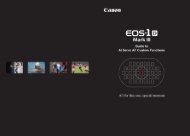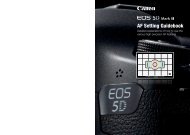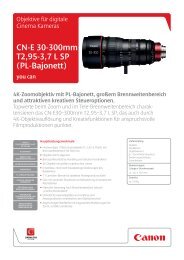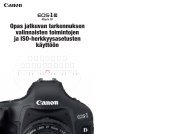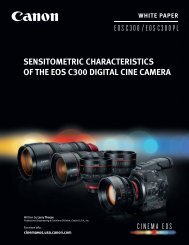THE CANON Eos-1ds MARK III CAMERA: EOS REBORN
THE CANON Eos-1ds MARK III CAMERA: EOS REBORN
THE CANON Eos-1ds MARK III CAMERA: EOS REBORN
You also want an ePaper? Increase the reach of your titles
YUMPU automatically turns print PDFs into web optimized ePapers that Google loves.
Lens Aberration Correction<br />
Function<br />
VI. SOFTWARE<br />
<strong>EOS</strong> Digital Solution Disk Ver.16 will ship with the <strong>EOS</strong>-1Ds Mark <strong>III</strong> camera at no additional<br />
cost. Each component is modified to bring <strong>EOS</strong>-1Ds Mark <strong>III</strong> compatibility to such things<br />
as RAW and sRAW files, as well as metadata.<br />
The new <strong>EOS</strong> Utility, ver.2.2, has 2 enhancements to Live View Function, a Test Shooting<br />
function and a Quick Preview function. Both are discussed in the Live View Function<br />
section of this paper.<br />
DPP (Digital Photo Professional) is upgraded from version 3.1 to 3.2. The 2 main additions<br />
are the lens aberration correction function and the brightness warning display function.<br />
While lens optics are designed to achieve the best possible balance in minimizing<br />
different types of aberrations and defects, these do remain, even if only minimally, as in<br />
reality it is impossible to eliminate aberrations completely. The new “Lens Aberration<br />
Correction Function” provides correction by way of image processing to handle divergences<br />
from ideal imaging.<br />
Aberration correction is achieved by re-processing the image, combining the following<br />
information with the photographed RAW image:<br />
1) The optical data for the lens:<br />
The DPP software includes data containing lens IDs and optical characteristics of<br />
each lens<br />
2) Lens information for the lens used (lens ID):<br />
Automatically recorded to the supplementary information for photographed RAW images<br />
3) The focal length information when shots are taken:<br />
Automatically recorded to the supplementary information for photographed RAW images<br />
4) The distance information when shots are taken:<br />
Automatically recorded to the supplementary information for photographed RAW images.<br />
Note: some of the specifications for recording the supplementary RAW image information in 2), 3) and 4) vary<br />
depending on the <strong>EOS</strong> Digital camera used.<br />
There are 4 factors that this function can correct:<br />
1) Peripheral illumination:<br />
Corrects peripheral light, which declines as one moves away from the center of the<br />
image, by increasing brightness at the image periphery so that brightness is uniform<br />
over the entire image<br />
VI. SOFTWARE 25




